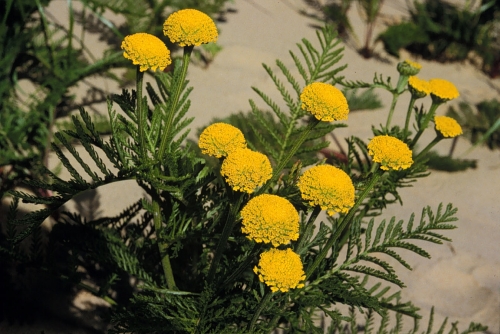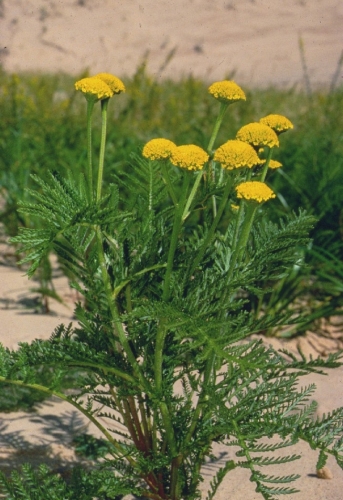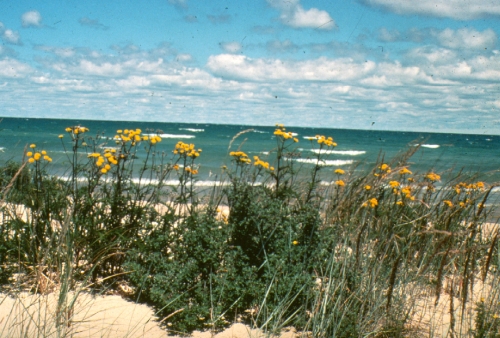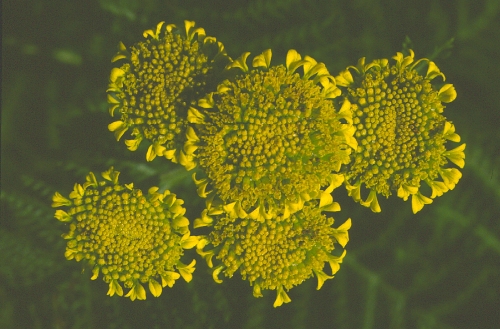Plants and Animals
Tanacetum bipinnatum ssp. huronense Lake Huron tansy
Key Characteristics
Perennial forb of northern dunes; arising from long, slender rhizomes, producing clumps of dissected, hairy, bipinnately compound leaves and terminal, long-stalked, yellow flower heads (13-19 mm broad) with obscure, short ray florets.
Status and Rank
US Status: No Status/Not Listed
State Status: SC - Special Concern (rare or uncertain; not legally protected)
Global Rank: G5T4T5
State Rank: S3 - Vulnerable
Occurrences
| County | Number of Occurrences | Year Last Observed |
|---|---|---|
| Alger | 5 | 2023 |
| Alpena | 1 | 1912 |
| Antrim | 5 | 2022 |
| Charlevoix | 24 | 2023 |
| Cheboygan | 7 | 2022 |
| Chippewa | 14 | 2021 |
| Delta | 4 | 2022 |
| Emmet | 12 | 2025 |
| Grand Traverse | 3 | 2018 |
| Leelanau | 4 | 2000 |
| Luce | 6 | 2022 |
| Mackinac | 29 | 2023 |
| Marquette | 1 | 1918 |
| Presque Isle | 8 | 2025 |
| Schoolcraft | 17 | 2025 |
Information is summarized from MNFI's database of rare species and community occurrences. Data may not reflect true distribution since much of the state has not been thoroughly surveyed.
Habitat
Lake Huron tansy occur along the Great Lakes shorelines in open dunes and along shores and beaches in sandy to rocky areas.
Natural Community Types
- Great lakes barrens
- Interdunal wetland
- Limestone cobble shore
- Open dunes
- Sand and gravel beach
- Wooded dune and swale complex
For each species, lists of natural communities were derived from review of the nearly 6,500 element occurrences in the MNFI database, in addition to herbarium label data for some taxa. In most cases, at least one specimen record exists for each listed natural community. For certain taxa, especially poorly collected or extirpated species of prairie and savanna habitats, natural community lists were derived from inferences from collection sites and habitat preferences in immediately adjacent states (particularly Indiana and Illinois). Natural communities are not listed for those species documented only from altered or ruderal habitats in Michigan, especially for taxa that occur in a variety of habitats outside of the state.
Natural communities are not listed in order of frequency of occurrence, but are rather derived from the full set of natural communities, organized by Ecological Group. In many cases, the general habitat descriptions should provide greater clarity and direction to the surveyor. In future versions of the Rare Species Explorer, we hope to incorporate natural community fidelity ranks for each taxon.
Associated Plants
Dune willows, dune grass, sea rocket, rock cress, sand cherry, wormwood, and Pitcher's thistle.
Management Recommendations
Protect integrity of dune habitats and natural dune processes that perpetuates habitat for this species.
Survey Methods
Random meander search covers areas that appear likely to have rare taxa, based on habitat and the judgment of the investigator.
-
Meander search
-
Survey Period: From third week of June to fourth week of August
-
References
Survey References
- Elzinga, C.L., D.W. Salzer, and J.W. Willoughby. 1998. Measuring and Monitoring Plant Populations. The Nature Conservancy and Bureau of Land Management, Denver. BLM Technical Reference 1730-1. 477pp.
- Goff, G.F., G.A. Dawson, and J.J. Rochow. 1982. Site examination for Threatened and Endangered plant species. Environmental Management 6(4): 307-316
- Nelson, J.R. 1984. Rare Plant Field Survey Guidelines. In: J.P. Smith and R. York. Inventory of rare and endangered vascular plants of California. 3rd Ed. California Native Plant Society, Berkeley. 174pp.
- Nelson, J.R. 1986. Rare Plant Surveys: Techniques For Impact Assessment. Natural Areas Journal 5(3):18-30.
- Nelson, J.R. 1987. Rare Plant Surveys: Techniques for Impact Assessment. In: Conservation and management of rare and endangered plants. Ed. T.S. Elias. California Native Plant Society, Sacramento. 8pp.
Technical References
- Antonio, T.M. and S. Masi. 2001.The Sunflower Family in the Upper Midwest. A Photographic Guide to the Asteraceae in Illinois, Indianan, Iowa, Michigan, Minnesota and Wisconsin. Indiana Academy of Science, Indianapolis. 421pp.
- Flora of North America Editorial Committee. 2006. Flora of North America, North of Mexico. Volume 19: Magnoliophyta: Asteridae (in part): Asteraceae, part 1. Oxford University Press, New York. 579pp.
- Gleason, H. A., and A. Cronquist. 1991. Manual of Vascular Plants of Northeastern United States and Adjacent Canada. 2nd Ed. The New York Botanical Garden, New York, New York.
- Gray, A. 1950. Gray's Manual of Botany; eighth ed. Van Nostrand Reinghold, New York. 1632pp.
- Holmgren, N.H. 1998. Illustrated Companion to Gleason and Cronquist's Manual. Illustrations of the vascular plants of Northeastern United States and adjacent Canada. New York Botanical Garden, Bronx. 937pp.
- Scoggan, H.J. 1978. The Flora of Canada. National Museum of Natural Science Publications Botany 4: 1711pp.
- Voss, E.G. 1996. Michigan Flora. Part III. Dicots (Pyrolaceae-Compositae). Bulletin of the Cranbrook Institute of Science and University of Michigan Herbarium. 622pp.





